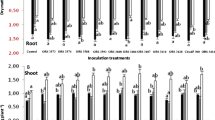Abstract
Cross-inoculation experiments were conducted in the greenhouse to test the rhizobia isolated from nodules of seven tree legumes for their effectiveness in Vigna mungo plants. The tree legumes included Albizia lebbeck, Dalbergia sissoo, Leucaena leucocephala, Pithecellobium dulce, Prosopis cineraria, Prosopis glandulosa and Prosopis juliflora, all growing under arid environment. Rhizobia from these legumes formed nodules on the roots of Vigna mungo except isolates from Albizia lebbeck. Dry weight and nitrogen contents of Vigna mungo plants increased significantly (P<0.05) in response to cross inoculation as compared to uninoculated control. Rhizobia from Leucaena leucocephala and Prosopis glandulosa showed significant increase in dry weight (P<0.05) and nitrogen contents (P<0.05) than other inoculated treatments. The natural rhizobia of wild tree legumes growing under arid environment show higher tolerance to prevailing adverse conditions like salt stress, elevated temperatures and drought. These rhizobia may be used to inoculate wild as well as crop legumes cultivated in reclaimed desert lands. These rhizobia may have specific traits that can be transferred to other rhizobia through genetic engineering tools. The cross infection of agriculturally important legumes with isolates from wild legumes may prove a useful means of increasing nitrogen contents within these plants.
Similar content being viewed by others
References
Amarger, N., (2001). Rhizobia in the field. Adv. Agron., 73, 109–168.
Aryal, U. K.; Hossain, M. K.; Mridha, M. A. U.; Xu, H. L.; Umemura, H., (1999). Effect of Rhizobium inoculation on growth, nodulation and nitrogenase activity of some tree species. J. Plant Nutr., 22, 1049–1059.
Basak, M. K.; Goyal, S. K., (1980). Studies on the biology of tree legumes-Rhizobium symbiosis: Nodulation pattern and cross inoculation trials with the tree legumes and cultivated legumes. Ann. Arid Zone, 9, 427–431.
Dahiya, J. S.; Khurana, A. L., (1981). Chillum Jar, a better technique for screening of rhizobia under summer condition. Plant and Soil, 63, 299–302.
Dommergues, Y. R.; Diem, H. G.; Gauthier, D. L.; Dreyfus, B. L.; Cornet, F., (1984). Nitrogen-fixing trees in the tropics: Potentials and limitations, In: Advances in nitrogen fixation research, C. Veeger and W. E. Newton (Ed.), Martinus Nijhoff/Dr. W. Junk Publishers, Wageningen, The Netherlands.
Duhoux, E.; Dommergues, Y. R., (1985). The use of nitrogen-fixing trees in forest and soil restoration in the tropics: In: Biological Nitrogen Fixation in Africa. H. Sali and S.O. Keya, (Eds.), Matianum Press Consultants, Nairobi.
Gour, Y. D., (1993). Microbiology, physiology and agronomy of nitrogen fixation: Legume-Rhizobium symbiosis. Proc. Indian Nat. Sci. Acad., B., 59, 333–358.
Herrera, A. M.; Bedmar, E. J.; Olivars, J., (1985). Host specificity of rhizobium strains isolated from nitrogen-fixing trees and nitrogenase activities of strain GRH2 in symbiosis with Prosopis chilensis. Plant Sci., 42, 177–182.
Hernandez, B. S.; Focht, D. D., (1984). Invalidity of the concept of slow growth and alkali production in cowpea rhizobia. Appl. Environ. Microbiol., 48, 206–210.
Iqbal, R.; Mahmood, A., (1992). Response of Leucaena leucocephala to inoculation with rhizobia from tropical legumes. Pak. J. Bot., 24, 153–156.
Javid, Z.; Fisher, R., (1989). Dinitrogen fixation (C2H2 reduction) by Dalbergia sissoo and Leucaena leucocephala with native rhizobial strains. Arid Soil Res. Rehab., 34, 385–390.
Lalani Wijesundara, T. I.; Van Holm, L. H. J.; Kulasooriya, S. A., (2000). Rhizobiology and nitrogen fixation of some tree legumes native to Sri Lanka. Biol. Fertil. Soils, 30, 535–543.
Moerira, F. M. S.; Gillis, M.; Port, B.; Kerstens, K.; Franco, A. A., (1993). Characterization of rhizobia isolated from different divergence groups of tropical Leguminosae by comparative polyacrylamide gel electrophoresis of their total proteins. Syst. Appl. Microbiol., 16, 135–146.
Moerira, F. M. S.; Hauska, K.; Young, J. P. W., (1998). Biodiversity of rhizobia isolated from a wide range of forest legumes in Brazil. Mol. Ecol., 7, 889–895.
Nelson, D. W.; Sommers, L. E., (1980). Determination of total nitrogen in plant material. Agron. J., 65, 109–112.
Padmanabhan, S.; Hirtz, R. D.; Broughton, W. J., (1990). Rhizobia in tropical legumes. Cultural characteristics of Bradyrhizobium and Rhizobium species. Soil Biol. Biochem., 22, 23–28.
Somasegaran, P.; Hoben, H. J., (1994). Handbook of Rhizobia: Methods in Legume Rhizobium Technology. Springer-Verlag, New York.
Trinick, M. J., (1980). Relationships amongst the fast-growing Rhizobia of Lablab purpureus, Leucaena leucocephala, Mimosa spp., Acacia farnesiana and Sesbania grandiflora and their affinities with other rhizobial groups. J. Appl. Bacterial., 49, 39–53.
Turk, D.; Keyser, H. H., (1992). Rhizobia that nodulate tree legumes: Specificity of the host for nodulation and effectiveness. Can. J. Microbiol., 38, 451–460.
Vessey, J. K.; Pawlowski, K.; Bergman, B., (2004). Root-based N2-fixing symbiosis: Legumes, actinorhizal plants, Parasponia sp. and cycads. Plant and Soil. 266, 205–230.
Wange, S. S., (1989). Response of groundnut (Arachis hypogaea L.) to inoculation with strains isolated from wild arboreal legumes. J. Appl. Microbiol. Biotech., 5, 135–141.
Zahran, H. H., (2001). Rhizobia from wild legumes: diversity, taxonomy, ecology, nitrogen fixation and biotechnology. J. Biotech., 91, 143–153.
Zahran, H. H.; Ahmad, M. S.; Abdel-Fatteh, M.; Zaki, A. Y., (1999). Phenotypic characteristics, cross nodulation and nitrogen fixation of root nodule bacteria isolated from wild leguminous plants in Egypt. Proc. Int. Symp. Biol. Nit. Fix. and Crop Prod., 77–90.
Zhang, X.; Harper, R.; Karisto, M.; Lindstrom, K., (1991). Diversity of Rhizobium bacteria isolated from the root nodules of leguminous trees. Int. J. Systm. Bacteriol., 41, 104–113.
Author information
Authors and Affiliations
Corresponding author
Rights and permissions
About this article
Cite this article
Mahmood, A., Athar, M. Cross inoculation studies: Response of Vigna mungo to inoculation with rhizobia from tree legumes growing under arid Environment. Int. J. Environ. Sci. Technol. 5, 135–139 (2008). https://doi.org/10.1007/BF03326006
Received:
Revised:
Accepted:
Published:
Issue Date:
DOI: https://doi.org/10.1007/BF03326006




